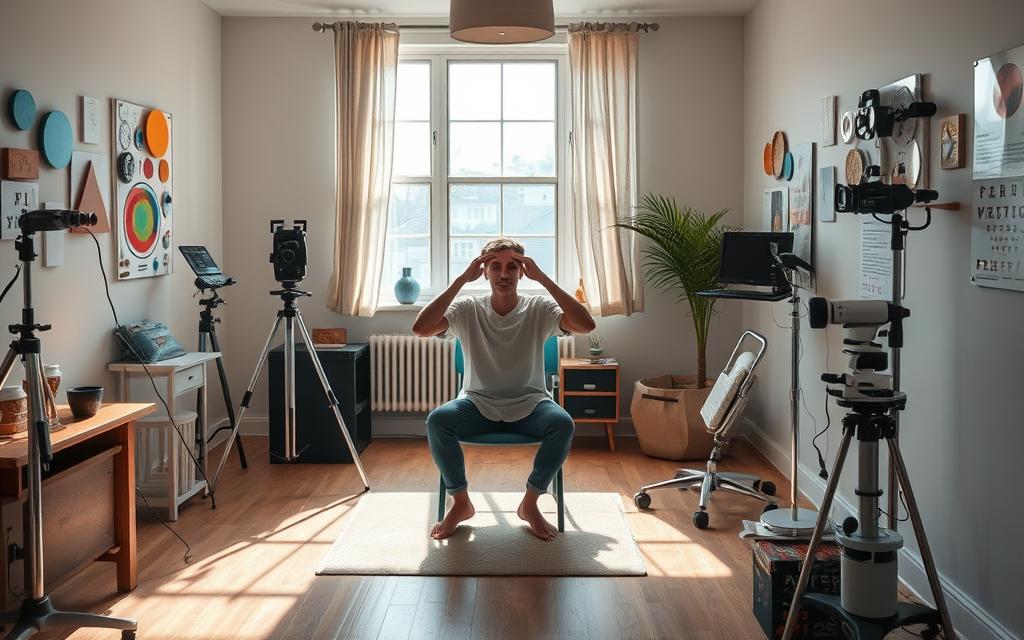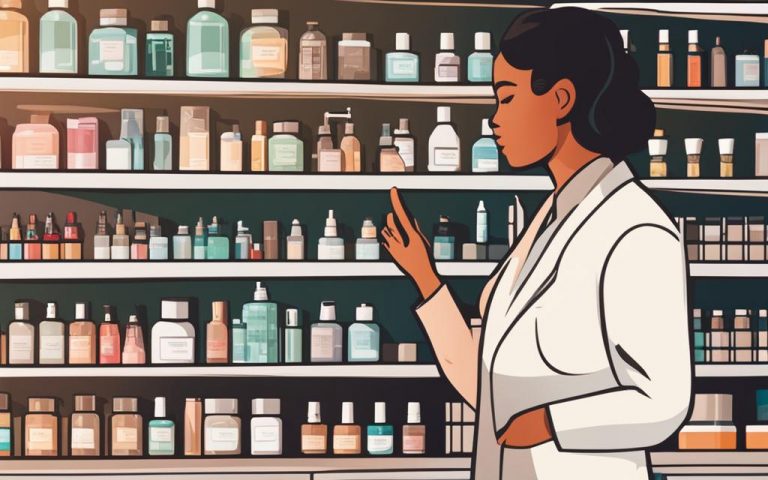Vision Therapy: Improve Your Eyesight Naturally
Are you tired of glasses or contacts? Vision therapy offers a natural way to better your eyesight. It uses eye exercises and relaxation to improve your vision. Unlike other methods, vision therapy doesn’t require surgery or medicine1.
Vision therapy can help with many eye problems. It’s great for eye alignment and focusing issues. For lazy eye (amblyopia), specific exercises work well1.
If you skip lines while reading or often close one eye, you might need eye exercises. Techniques include pencil push-ups and focusing on near and far objects1.
But, vision therapy isn’t a fix for everything. Some experts question its benefits for certain conditions. It’s important to get regular eye checks to find any serious problems1.
What you eat also affects your eye health. Foods like carrots, kale, and spinach are good for your eyes. They have vitamins and nutrients that help keep your vision sharp2.
Key Takeaways
- Vision therapy uses eye exercises to improve eyesight naturally
- It can help with eye alignment and focusing issues
- Specific exercises benefit conditions like lazy eye
- Regular eye exams are essential for overall eye health
- A diet rich in vitamin A and lutein supports vision
- Vision therapy’s effectiveness varies for different conditions
Understanding Vision Therapy
Vision therapy is a special type of eye training. It aims to make vision better and more efficient. It helps with different eye problems and boosts how well we see things.
Definition and Purpose
This therapy uses exercises and activities to make eye muscles stronger. It’s designed to fix vision issues that can affect everyday life. Studies show it can really help kids who find reading or schoolwork hard3.
Historical Background
Vision therapy started in the early 1900s. Early optometrists created ways to help with eye coordination and how we process what we see. These methods have grown into the detailed vision training we know today.

Scientific Basis
There’s ongoing debate about how effective vision therapy is, but some studies look promising. For example, a study by the National Eye Institute found it helped 75% of patients with convergence insufficiency3. Researchers at Boston Children’s Hospital are also studying it more3.
Here are some stats on vision therapy:
- 60 million American adults have symptoms of a binocular vision disorder4.
- About 50% of kids with learning issues have a vision problem that makes learning hard4.
Even with these positive results, not all eye care experts agree on vision therapy. We need more studies to understand its benefits for different vision issues.
The Controversy Surrounding Natural Vision Correction
Natural vision correction and its effects on eye health have caused a lot of debate. Some eye care experts support these methods, but others doubt their success.
In 2013, the American Academy of Ophthalmology said natural vision correction doesn’t help with nearsightedness or other vision issues5. The American Association of Pediatric Ophthalmology and Strabismus also found no proof that vision therapy can fix nearsightedness or stop it from getting worse5.
Optometrists believe vision therapy can help with learning disabilities and improve learning skills. But ophthalmologists say there’s no solid science backing this claim6.
Optometrist Leonard Press thinks visual therapy can help with specific eye problems like convergence insufficiency5. The Bates Method, introduced in 1920, aims to improve vision without glasses. Yet, not all eye doctors think it works well5.
“Why strain to see when you can use tools that immediately improve vision?”
Ophthalmologist Rachel Bishop asks this question, showing the debate between natural vision correction and traditional eye care5. In 2009, the American Academy of Pediatrics and the American Academy of Ophthalmology said vision therapy has no scientific backing6.
We need more research to figure out how to make vision therapy work for everyone6. Until then, the debate on natural vision correction and eye health will keep going.
How Vision Therapy Works
Vision therapy is a powerful tool for improving eyesight naturally. It targets various visual skills and conditions. Let’s see how it works and who can benefit from it.
Principles of Vision Therapy
Vision therapy uses the idea of neuroplasticity. It aims to retrain your visual system with targeted exercises. These exercises improve eye-tracking, focusing, convergence, and visual processing speed. Vision rehab helps both children and adults, offering hope to many7.
Target Conditions
Vision therapy helps with many conditions. It’s great for people with convergence insufficiency, affecting 5-15% of people. It also helps computer users with eyestrain, a common issue for 50-90% of screen workers8. Other conditions it targets include:
- Strabismus (eye turn)
- Amblyopia (lazy eye)
- Eye-tracking problems
- Visual processing issues
Professional Guidance vs. Self-Help
While some exercises can be done at home, getting professional help is key. An optometrist can tailor a program for your needs. Results often show up in a few weeks, with full treatment taking up to six months7.
| Symptoms Addressed | Potential Improvements |
|---|---|
| Headaches after reading | Reduced eye strain |
| Poor hand-eye coordination | Enhanced sports performance |
| Double vision | Improved visual clarity |
| Dizziness or motion sickness | Better balance and coordination |
Studies show vision therapy has great results. It boosts visual skills and reading in kids with Down syndrome. It also treats amblyopia by strengthening eye-brain connections8. With its many benefits, vision therapy offers a natural way to better eyesight and a better life.
Benefits of Vision Therapy
Vision therapy helps people with eye problems in many ways. It’s a safe way to improve your vision and ease eye strain. Many people of all ages have seen big improvements9.
It makes your eyes work better together. This means you’ll focus better and see more clearly. It’s great for reading, writing, and learning, especially if you’ve had trouble before10.
If you have eye issues like eye turns or lazy eyes, vision therapy is a good choice instead of surgery. It works well for adults and kids over 2110. Kids often do better in school and sports after trying it out9.
With more screen time, computer vision syndrome is a big problem. Vision therapy can ease eye strain from looking at screens all day10. Adults tend to get better faster because they’re motivated to succeed9.
It’s also great for sports. It boosts your eye-hand coordination, quick thinking, and seeing things around you. These are key for athletes10. You’ll start seeing changes in your vision in just a few weeks with the right therapy9.
Common Vision Problems Addressed by Vision Therapy
Vision therapy helps with many eye disorders, giving hope for better vision. It’s useful for both kids and adults with common vision problems.
Convergence Insufficiency
Convergence insufficiency affects about 15 percent of people11. It makes focusing on close things hard. Vision therapy exercises can make eye muscles stronger and improve coordination. This reduces eye strain and headaches.
Strabismus (Eye Turn)
Strabismus, or crossed eyes, leads to blurry or double vision and poor depth perception11. Vision therapy helps eyes work together better, improving vision. It often uses exercises and special tools to fix eye alignment.
Amblyopia (Lazy Eye)
Amblyopia, or lazy eye, often starts in early childhood11. If not treated, it can lead to poor depth perception. Therapy for amblyopia makes the weaker eye stronger. This improves visual clarity and binocular vision.
About 60 percent of people with Down Syndrome have amblyopia or strabismus11. Vision therapy is especially good for them, enhancing their vision and life quality.
Vision therapy also helps with other eye issues like accommodative dysfunction and visual processing disorders12. It’s great for athletes and people with computer vision syndrome. By focusing on these problems, vision therapy can greatly improve vision skills and comfort for many.
Vision Therapy Techniques and Exercises
Vision therapy uses eye exercises and techniques to boost your vision. These exercises focus on skills like eye coordination, tracking, and depth perception13. Doing these exercises can make your eyes healthier and more comfortable.
Some common exercises include pencil push-ups and focusing on near and far objects. The Brock String technique also helps with eye coordination. These exercises help improve how accurately you see and react14.
Palming is a way to relax by covering your eyes with your palms. Blinking more can also reduce eye strain, especially from screens. Experts suggest the 20-20-20 rule: look at something 20 feet away for 20 seconds every 20 minutes14.
It’s important to get advice from an eye doctor or vision therapist for these exercises13. Remember, these exercises can ease eye strain but don’t fix all vision issues14.
Adding these techniques to your daily life can help improve your vision and eye health.
The Role of Nutrition in Eye Health
Good nutrition is key to keeping your eyes healthy. Eating a balanced diet full of certain vitamins and minerals helps your vision and prevents eye problems. Let’s look at the key nutrients for eye health and foods that help your eyesight.
Essential Vitamins for Eye Health
Many vitamins are important for your eyes. Vitamin A is crucial for night vision and is found in animal and some plant foods. You can also get it from egg yolks, dairy, liver, spinach, and carrots15.
Vitamin C is in fruits and veggies like broccoli, kale, peppers, and oranges. It helps the fluid in front of your eyes. Vitamin E protects fatty acids from damage and is in almonds, sunflower seeds, and avocados15.
Foods That Promote Better Vision
Adding certain foods to your diet can improve your eye health. Lutein and zeaxanthin, key for the eyes, are in chard, spinach, kale, raspberries, and peaches. Flavonoids, which help retinal ganglion cells, are in dark chocolate, red wine, berries, citrus, and tea15.
Omega-3 fatty acids are good for eye health and reduce inflammation. You can find them in salmon, mackerel, sardines, flaxseeds, chia seeds, and walnuts. The Mediterranean diet is full of nutrients like vitamins A, C, and E, carotenoids, selenium, and omega-3 fatty acids15.
Studies show antioxidants help prevent age-related eye problems like macular degeneration and cataracts. Research also looks at how antioxidants and vitamin supplements can slow or prevent cataracts16.
By eating right and getting the right vitamins, you can help your vision and eye health naturally.
Vision Therapy for Children
Pediatric vision therapy is now seen as a possible way to help kids with eye issues. It uses special eye exercises to boost visual skills and fix eye problems.
Kids do vision therapy with eye exercises every week for a few months. They can do these at an optometrist’s or at home17. The goal is to improve vision and help with problems like amblyopia or convergence insufficiency.
Some parents say vision therapy has helped their kids. But, it’s key to know that there’s not much science backing it up. Studies show that “training glasses” don’t really help much18.
For kids who are having trouble in school, seeing an eye doctor who knows about kids is best. They can check for vision problems and give the right advice18. This makes sure the child gets a thorough check before trying other treatments.
“Current research does not support claims that vision therapy improves visual efficiency or effectively treats learning disabilities long-term.”
Eye exercises given by eye doctors can help kids with eye movement issues. These problems can cause blurry vision, double vision, or headaches18. These exercises are different from vision therapy and are for specific problems.
There’s still debate on how well vision therapy works. Parents should be careful and talk to eye care experts to find the best way to help their child’s eyes.
Vision Therapy for Adults
Vision therapy isn’t just for kids. Adults can also benefit a lot from it, especially with age-related vision problems or eye strain from work. Let’s see how adult vision therapy can boost your eye health and make work more comfortable.
Age-Related Vision Issues
As we get older, our eyes change, which can affect how we see things. Adult vision therapy can tackle these changes and keep our eyes healthy. It works just as well for adults as it does for kids, thanks to the brain’s ability to change and adapt19.
Lazy eye, or amblyopia, affects about 1 in 33 people, which could be up to 10 million in the USA20. The good news is, vision therapy can really help adults with lazy eye19.
Occupational Vision Concerns
Many adults have eye strain from staring at computer screens for long hours. Vision therapy can ease these problems by making your vision better and reducing eye strain.
Adult vision therapy might include exercises like focusing on different distances, tracking your eyes, and using special tools19. These exercises are great for those with eye problems at work.
| Vision Issue | Effectiveness of Vision Therapy |
|---|---|
| Convergence Insufficiency | Most effective treatment |
| Strabismus (Eye Turn) | Effective treatment |
| Amblyopia (Lazy Eye) | Significant improvement |
Adults are often more motivated and dedicated to improving their vision with therapy19. This effort, along with vision therapy’s success in treating various eye issues, makes it a great choice for adults wanting better eye health and less eye strain at work.
The Bates Method: A Historical Perspective
The Bates Method was created in 1891 by William Horatio Bates, an eye doctor2122. He got his medical degree from Columbia University in 1885. He then taught ophthalmology at the New York Postgraduate Medical School and Hospital from 1886 to 189122.
Dr. Bates believed that eye strain, not the eye’s shape, caused vision problems21. He said he fixed seven cases of nearsightedness and taught kids to see better21.
The Bates Method uses techniques like palming and eye exercises to help eyes21. It aims to ease eye issues like short sight and long sight23.
In 1920, Bates wrote a book on seeing better without glasses21. The Federal Trade Commission criticized it in 1929 for false ads21. Yet, the Bates Method is still taught in many countries23.
Some like the method, but science doesn’t back it up. In 1952, a professor said most of Bates’ ideas were wrong21.
Following the Bates method can be risky, like getting too much sun or ignoring regular eye care21. Always talk to eye experts before trying new ways to improve your vision.
Combining Vision Therapy with Traditional Eye Care
Vision therapy and traditional eye care work together for better vision. This approach treats both symptoms and causes of vision issues. It helps with problems like amblyopia, strabismus, and convergence insufficiency24.
This therapy improves eye tracking, focusing, depth perception, and how fast you process visual information24. Mixing these with traditional care gives you a complete treatment plan. This often leads to better results that last a long time.
How long and complex vision therapy programs are depends on your condition25. Your eye doctor will make a plan just for you. It might include special glasses and exercises. This way, you get the best treatment for your needs.
Regular eye exams are key in this approach. They check your eye health and catch serious problems early. By using vision therapy with traditional care, you’re taking a proactive step for your eye health.
| Traditional Eye Care | Vision Therapy | Integrated Approach |
|---|---|---|
| Regular eye exams | Specialized exercises | Comprehensive assessment |
| Corrective lenses | Visual function improvement | Personalized treatment plan |
| Disease detection | Root cause addressing | Enhanced overall outcomes |
This approach can make your eyes more comfortable, improve coordination, and boost reading skills24. Using both traditional and new methods helps your eyes stay healthy and work well.
Success Stories and Case Studies
Vision therapy has greatly improved many eye conditions. People of all ages have shared how it helped them. Let’s look at some stories that show how vision therapy works.
Children often get a lot of help from vision therapy. Spencer, who was 13, read better after vision therapy26. Amanda, 9, did her homework faster and was happier in just three weeks after ten sessions26.
Teenagers also see big improvements. Kelsey, 12, got better at using her eyes and reading after 16 weeks26. Lauren, 11, read more confidently and enjoyed reading on her own26.
Adults can also benefit. Val fixed her eye coordination with vision therapy and became a pro golfer with many wins27.
| Patient | Age | Duration | Improvements |
|---|---|---|---|
| Spencer | 13 | Not specified | Reading skills |
| Amanda | 9 | 3 weeks | Homework completion, attitude |
| Kelsey | 12 | 16 weeks | Eye-hand coordination, reading grades |
| Lauren | 11 | Not specified | Reading grade level, confidence |
| Val | Adult | Few months | Eye coordination, professional golf career |
People with autism have also seen good results from vision therapy. A study showed 45% of autistic patients got better with it28. Autistic kids using special lenses caught balls better in games28.
These stories and studies show how vision therapy can help improve vision and life quality for many.
Limitations and Considerations of Vision Therapy
Vision therapy can help with some eye issues, but it’s important to know its limits. It’s not a fix for every eye problem. We’ll look at when it might not work and the risks you should know about.
When Vision Therapy May Not Be Effective
Vision therapy doesn’t fix problems like myopia (nearsightedness) or hyperopia (farsightedness)29. These usually need glasses or surgery. If you have eye defects or diseases, it might not be the best option. Always get an eye check before starting therapy.
It works for people of all ages, but its success can differ. Kids as young as three months can benefit to catch and treat eye issues early29. Adults can too, especially for problems from brain injuries, stroke, amblyopia, and strabismus30.
Potential Risks and Side Effects
Vision therapy is usually safe, but it can have risks. You might feel eye strain or headaches at first. Always work with a skilled eye care professional to lessen these risks. Remember, it doesn’t cure conditions like autism or learning disabilities, and it doesn’t mean you won’t need glasses31. Talk to your eye doctor to see if vision therapy is right for you.
FAQ
What is vision therapy?
Vision therapy helps improve eyesight without glasses, contact lenses, drugs, or lasers. It uses eye exercises, relaxation, and massages to boost visual skills.
Is there scientific evidence supporting vision therapy?
The science on vision therapy is mixed. Some conditions show improvement, but not all. The American Academy of Ophthalmology says it doesn’t fix nearsightedness or stop it from getting worse.
How does vision therapy work?
It’s based on the brain’s ability to change, or neuroplasticity. Vision therapy uses special activities to improve vision skills. It helps with issues like eye alignment and focusing.
What are the potential benefits of vision therapy?
It can make eyes work better together, improve focus, and enhance visual skills. It may also ease eye strain, headaches, and make reading easier.
What vision problems can vision therapy address?
It’s great for convergence insufficiency, strabismus, and amblyopia. These issues often respond well to specific exercises and training.
What are some common vision therapy exercises?
Exercises include pencil push-ups, focusing on near and far, and tracking figures. There’s also palming, blinking, and using tools like barrel cards.
What role does nutrition play in eye health?
Good nutrition is key for eye health. Foods rich in Vitamin A and lutein, like carrots and spinach, help eye health and support vision therapy.
Is vision therapy effective for children?
Yes, it’s great for kids, especially for amblyopia and convergence insufficiency. Early treatment works best, and it uses fun activities.
Can adults benefit from vision therapy?
Absolutely, adults can benefit from it, especially for age-related vision issues and computer vision syndrome. It adapts to work-related eye needs.
What is the Bates Method?
The Bates Method, by Dr. William Bates in 1920, suggests natural ways to improve vision without glasses. It includes techniques like palming and movement. But, it’s not proven by science and isn’t supported by most eye doctors.
Can vision therapy be combined with traditional eye care?
Many eye experts say to use vision therapy with traditional care, like glasses and exercises. This approach gives full eye care.
Are there any limitations or risks associated with vision therapy?
It might not work for all eye problems, especially those from physical eye issues or diseases. It can cause eye strain or headaches at first. Always get professional advice to avoid risks and get the most benefit.
Source Links
- https://kraffeye.com/blog/8-easy-eye-exercises-to-improve-vision-techniques-and-tips – 8 Easy Eye Exercises to Improve Vision: Techniques and Tips | Kraff Eye Institute
- https://coopervision.com/eye-health-and-vision/improving-eyesight-naturally – Simple Steps for Improving Your Eyesight
- https://www.childrenshospital.org/programs/vision-therapy-service/faqs – Boston Children’s Hospital
- https://www.optometrists.org/vision-therapy/guide-to-vision-therapy/ – Guide to Vision Therapy
- https://www.webmd.com/eye-health/features/natural-vision-correction-does-it-work – Natural Vision Correction: Does It Work?
- https://www.rebuildyourvision.com/blog/eye-doctors/vision-therapy-controversial-topic/ – Why Is Vision Therapy a Controversial Topic?
- https://www.optometrists.org/vision-therapy/guide-to-vision-therapy/what-is-vision-therapy/ – What Is Vision Therapy?
- https://www.newbaltimoreoptometrist.com/7-eye-conditions-that-can-be-treated-with-vision-therapy/ – 7 Eye Conditions That Can Be Treated With Vision Therapy
- https://www.optometrists.org/vision-therapy/guide-to-vision-therapy/what-are-the-benefits-of-vision-therapy/ – What Are the Benefits of Vision Therapy?
- https://tec.sco.edu/who-benefits-from-vision-therapy – Who Benefits from Vision Therapy? | The Eye Center
- https://www.optometrists.org/vision-therapy/guide-to-vision-therapy/9-eye-conditions-improved-with-vision-therapy/ – 9 Eye Conditions Improved With Vision Therapy
- https://bellevuesec.com/what-conditions-can-vision-therapy-treat/ – What Conditions Can Vision Therapy Treat?
- https://www.optometrists.org/vision-therapy/guide-to-vision-therapy/eye-exercises-you-can-do-at-home/ – Eye Exercises You Can Do at Home
- https://www.clarksoneyecare.com/eye-care-resources/4-vision-therapy-exercises-you-can-try-at-home – Vision Therapy Exercises to Try at Home | Clarkson Eyecare
- https://www.hopkinsmedicine.org/health/wellness-and-prevention/nutrition-and-eye-health – Nutrition and Eye Health
- https://www.ncbi.nlm.nih.gov/pmc/articles/PMC6771137/ – Nutrition and Eye Health
- https://www.tsbvi.edu/tx-senseabilities/issues/tx-senseabilities-fall-2022-issue/vision-therapy-an-update – Vision Therapy: An Update
- https://aapos.org/glossary/vision-therapy – Vision Therapy – American Association for Pediatric Ophthalmology and Strabismus
- https://www.optometrists.org/vision-therapy/guide-to-vision-therapy-for-adults/2021-update-vision-therapy-for-adults/ – 2021 Update: Vision Therapy for Adults
- https://www.optometrists.org/vision-therapy/guide-to-vision-therapy-for-adults/vision-therapy-for-adults/ – Vision Therapy for Adults
- https://en.wikipedia.org/wiki/Bates_method – Bates method
- https://www.naturalvisionteachers.org/about-william-bates – About the Bates Method — Association of Vision Educators
- https://seeing.org/ – Bates Method International – The Bates Method of Vision Education
- https://wilmingtonfamilyeyecare.com/understanding-optometric-vision-therapy-and-its-uses-in-eyecare/ – Understanding Optometric Vision Therapy and Its Uses in Eyecare
- https://www.aoa.org/AOA/Documents/Practice Management/Coding/TherapyandNeuroRehabitationCoding2020.pdf – PDF
- https://www.optometrists.org/vision-therapy/guide-vision-and-learning-difficulties/vision-therapy-for-reading-improvement-success-stories/ – Vision Therapy: Success Stories
- https://www.lynnhellerstein.com/casestudies/ – Case Studies – Lynn Hellerstein
- https://www.optometrists.org/childrens-vision/vision-therapy-for-special-needs/autism-vision/vision-therapy-for-autism-success-stories/ – Vision Therapy for Autism: Success Stories
- https://www.webmd.com/eye-health/what-to-know-about-vision-therapy – What to Know About Vision Therapy
- https://www.goldeneyeclinic.net/vision-therapy-treatments-teens-vs-adults/ – Vision Therapy Treatments: Teens vs Adults
- https://www.tsbvi.edu/tx-senseabilities/issues/summer-2018/controversies-surrounding-vision-therapy – Controversies Surrounding Vision Therapy







